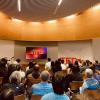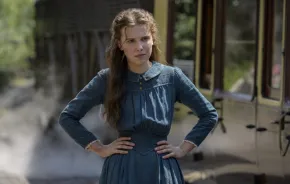It's another 3-D day in Seattle: dreary, dark and drizzly. We know we should be thankful it's not 10 below zero and blizzarding. But still: Is it too much to ask for a blink of sunshine and blue sky, and a glimpse of the mountain scenery we all live for?
Pacific Science Center has the recipe for your family's winter blues: A new 3-D IMAX film that lets you travel to most glorious of our country's national parks, and a new exhibit that spurs your kids to play with mathematical concepts and work out their wiggles at the same time.
This land is your land, in 3-D IMAX
Just opened last week at Pacific Science Center's state-of-the-art Boeing IMAX theater, National Parks Adventure 3-D is a stunning homage to what some have called our country's "best idea": The National Park Service, celebrating its centennial this year. (Fun fact: Yellowstone became the first national park in 1872, but the National Park Service was not established until 1916; it now comprises more than 400 national parks, monuments, battlefields, historic sites, lakeshores, seashores and more.)
Produced by Greg MacGillivray, narrated by Robert Redford and filmed in luscious IMAX 3-D, the 43-minute film visits more than 30 of our most spectacular national parks and sites. Though some would argue that a film dedicated to sharing this splendor wouldn't need more of a premise, a road-trip narrative threads the scenes together. The film follows mountaineer Conrad Anker, his stepson, adventure photographer Max Lowe, and their artist friend Rachel Pohl as they travel from park to park.

They are not ordinary day hikers: They climb sheer rock faces at Yosemite, mountain bike around Utah canyons, raft through the Grand Canyon and — most dramatically — ice-climb up a frozen waterfall in 20-below weather at Pictured Rocks National Lakeshore in Michigan. And because it's 3-D, you are right there with them: clambering down Devils Tower to avoid being struck by lightning, ducking to avoid shards of ice kicked out by an ice axe during the waterfall climb. The film also dips into history, recreating a famous camping trip by John Muir and Theodore Roosevelt, where Roosevelt first conceived of the idea of the National Park Service.
The history/travelogue/adventure mix isn't always successful: While thrill-seeking kids will likely enjoy the up-close shots of the trio's adventures, I found their story somewhat distracting from the glory of the national parks themselves. (An unintended underlying message: You have to be a super-fit climber/biker/rafter to best enjoy our national parks.)
And though the environmental message about preservation was there (particularly in a segment on Redwood National Park), I wish it had been more prominent.

Still, there's more than enough of that unparalleled IMAX footage of national parks — viewers soar over the amazing topography of Yellowstone's sulfurous geysers, bob above the Colorado River as it cuts through the Grand Canyon, go nose-to-nose with a screeching, slightly terrifying prairie dog — to make the film worth seeing, especially on one of Seattle's 3-D days.
Don't forget to follow with a conversation with your kids about what should be on your family's national-park travel list.
On suggested age for the film: One dramatic scene of a forest fire in Yosemite may scare younger kids (though it's thrilling, and gives insight into why fires are such a necessary part of forest ecology). Also, my son at age 5 couldn't tolerate the noise level and in-your-faceness of IMAX, but you will know best about your own children's tolerance.

Fast-moving numbers fun at Math Moves exhibit
After sitting in an IMAX theater, which gives the illusion of flight though you're not moving at all, a logical next stop is Pacific Science Center's Math Moves exhibit, showing until May 1.
Got a math-anxious kid or one who revels in number play? Both will enjoy aspects of this exhibit, with a variety of interactive displays that engages children of a range of ages.
In "Balance and Imbalance," kids can play with weights and a fulcrum. Kids interested in art and design will love the "Drawing with Gears" stations, a Spirograph-like activity where they can spin out all sorts of designs, changing gears to experiment with different shapes.
Nearby at "Partner Motion," two people can graph their activity while running and walking in place (the exhibit has a number of activities you can do in tandem). At "Moving Shadows," you can literally see how shadows are cast differently during the course of the day.

Many of the more complex math concepts went over my 6-year-old's head when we visited Math Moves last week, but he still enjoyed a number of the stations. He and his buddy particularly gravitated toward the "Sensing Ratios" station where you moved knobs to trace a circle and "Motion Math," where they moved in time to a beat along the points of a triangle, varying between half time and double time. It seemed designed to spur silliness.

Other highlights of the exhibit are the stop-motion animation stations, where kids can take snapshots of figures and props to create mini-movies; and "Comparing Frequencies," where kids can move wheels along a clicker to experiment with math music.
I'd recommend the exhibit for ages 5 and older, though younger kids can find enough to do, and there is a tots' station in the center with puzzles, books, blocks and more. If your kid isn't enthralled, be prepared with a backup activity; luckily, there is no shortage at the Pacific Science Center, from the butterfly exhibit to naked mole rats and the planetarium.
 If you go ...
If you go ...
Where: Pacific Science Center, 200 Second Ave. N, Seattle, WA 98109
When: National Parks Adventure 3-D is currently playing at the Boeing IMAX Theater; Math Moves is on through May 1, 2016.
Cost: $11.75–$19.75 for exhibits; $6–$10 for IMAX; $13.75–$25.75 for both IMAX and exhibits.
Tip: If you need more wiggly fun, follow with a trip to the free Artists at Play playground, near the Armory, with its towering slides, climbing challenges and labyrinth.











